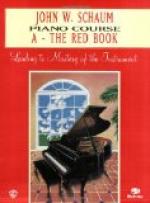“For me there is one pianist who stands above them all—his name is Gabrilowitsch.”
The quality of tone which this rare artist draws from his instrument, is unforgettable. I asked him one morning, when he was kind enough to give me the opportunity for a quiet chat, how he produced this luscious singing quality of tone.
“A beautiful tone? Ah, that is difficult to describe, whether in one hour or in many hours. It is first a matter of experiment, of individuality, then of experience and memory. We listen and create the tone, modify it until it expresses our ideal, then we try to remember how we did it.
“I cannot say that I always produce a beautiful tone; I try to produce a characteristic tone, but sometimes it may not be beautiful: there are many times when it may be anything but that. I do not think there can be any fixed rule or method in tone production, because people and hands are so different. What does for one will not do for another. Some players find it easier to play with high wrist, some with low. Some can curve their fingers, while others straighten them out. There are of course a few foundation principles, and one is that arms and wrists must be relaxed. Fingers must often be loose also, but not at the nail joint; that must always be firm. I advise adopting the position of hand which is most comfortable and convenient. In fact all forms of hand position can be used, if for a right purpose, so long as the condition is never cramped or stiff. I permit either a high or low position of the wrist, so long as the tone is good. As I said, the nail joint must remain firm, and never be crushed under by the weight of powerful chords, as is apt to be the case with young players whose hands are weak and delicate.
[Illustration: TO MISS HARRIETTE BROWER, OSSIP GABRILOWITSCH]
TECHNICAL STUDY
“Yes, I am certainly in favor of technical practise outside of pieces. There must be scale and arpeggio study, in which the metronome can be used. But I believe in striving to make even technical exercises of musical value. If scales are played they should be performed with a beautiful quality and variety of tone; if one attempts a Czerny etude, it should be played with as much care and finish as a Beethoven sonata. Bring out all the musical qualities of the etude. Do not say, ’I’ll play this measure sixteen times, and then I’m done with it.’ Do nothing for mechanical ends merely, but everything from a musical standpoint. Yes, I give some Czerny to my students; not many etudes however. I prefer Chopin and Rubinstein. There is a set of six Rubinstein Studies which I use, including the Staccato Etude.
“In regard to technical forms and material, each player may need a different tonic. I have found many useful things in a work by your own Dr. William Mason, Touch and Technic. I have used this to a considerable extent. To my knowledge he was the first to illustrate the principle of weight, which is now pretty generally accepted here as well as in Europe.




